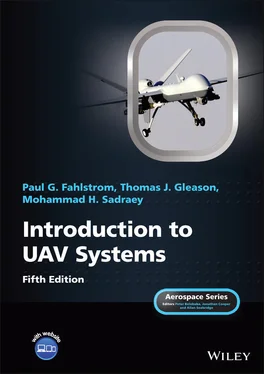Library of Congress Cataloging‐in‐Publication Data
Names: Fahlstrom, Paul Gerin, author. | Gleason, Thomas J., author. | Sadraey, Mohammad H., author.
Title: Introduction to UAV systems / Paul Gerin Fahlstrom, Thomas James Gleason, Mohammad H. Sadraey.
Description: Fifth edition. | Hoboken, NJ : Wiley, 2022. | Series: Aerospace series | Includes bibliographical references and index.
Identifiers: LCCN 2022001629 (print) | LCCN 2022001630 (ebook) | ISBN 9781119802617 (cloth) | ISBN 9781119802631 (adobe pdf) | ISBN 9781119802624 (epub)
Subjects: LCSH: Drone aircraft. | Cruise missiles.
Classification: LCC UG1242.D7 F34 2022 (print) | LCC UG1242.D7 (ebook) | DDC 623.74/69–dc23/eng/20220202
LC record available at https://lccn.loc.gov/2022001629LC ebook record available at https://lccn.loc.gov/2022001630
Cover Design: Wiley
Cover Image: © MQ‐9 Reaper unmanned aerial vehicle, public domain, Wikimedia Commons
This book is dedicated to our wives, Beverly Ann Evans Fahlstrom, Archodessia Glyphis Gleason, and Seyedeh Zafarani, who have provided support and encouragement throughout the process of its preparation.
Introduction to UAV Systems , Fifth Edition, has been written to meet the needs of both newcomers to the world of unmanned aerial vehicle (UAV) systems and experienced members of the UAV community who desire an overview and who, though they may find the treatment of their particular discipline elementary, will gain valuable insights into the other disciplines that contribute to a UAV system. The material has been presented such that it is readily understandable to college freshman and to both technical and nontechnical persons working in the UAV field, and is based on standard engineering texts as well as material developed by the authors while working in the field. Most equations have been given without proof and the reader is encouraged to refer to standard texts of each discipline when engaging in actual design or analysis as no attempt is made to make this book a complete design handbook.
This book is also not intended to be the primary text for an introductory course in aerodynamics or imaging sensors or data links. Rather, it is intended to provide enough information in each of those areas, and others, to illustrate how they all play together to support the design of complete UAV systems and to allow the reader to understand how the technology in all of these areas affect the system‐level tradeoffs that shape the overall system design. As such, it might be used as a supplementary text for a course in any of the specialty areas to provide a system‐level context for the specialized material.
For a beginning student, we hope that it will whet the appetite for knowing more about at least one of the technology areas and demonstrate the power of even the simplest mathematical treatment of these subjects in allowing understanding of the tradeoffs that must occur during the system design process.
For a UAV user or operator, we hope that it will provide understanding of how the system technology affects the manner in which the UAV accomplishes its objectives and the techniques that the operator must use to make that happen.
For a “subject matter expert” in any of the disciplines involved in the design of a UAV system, we hope that it will allow better understanding of the context in which his or her specialty must operate to produce success for the system as a whole and why other specialists may seem preoccupied with things that seem unimportant to him or her.
Finally, for a technology manager, we hope that this book can help him or her understand how everything fits together, how important it is to consider the system‐integration issues early in the design process so that the integration issues are considered during the basic selection of subsystem designs, and help him or her understand what the specialists are talking about and, perhaps, ask the right questions at critical times in the development process.
Part Onecontains a brief history and overview of UAVs in Chapter 1and a discussion of classes and missions of UAVs in Chapter 2.
Part Twois devoted to the design of the air vehicle including basic aerodynamics, performance, stability and control, propulsion and loads, structures and materials in Chapters 3through 7.
Part Threediscusses the mission planning, control function, and autopilot in Chapter 8and operational control in Chapter 9.
Part Fourhas three chapters addressing payloads. Chapter 10discusses the most universal types of payloads, reconnaissance, and surveillance sensors. Chapter 11discusses weapons payloads, a class of payloads that has become prominent since its introduction about 10 years ago. Chapter 12discusses a few of the many other types of payloads that may be used on UAVs.
Part Fivecovers data links, the communication subsystems used to connect the air vehicle to the ground controllers, and delivers the data gathered by the air‐vehicle payloads. Chapter 13describes and discusses basic data‐link functions and attributes. Chapter 14covers the factors that affect the performance of a data link, including the effects or intentional and unintentional interference. Chapter 15addresses the impact on the operator and system performance of various approaches to reducing the data‐rate requirements of the data link to accommodate limitations on available bandwidth. Chapter 16summarizes data‐link tradeoffs, which are one of the key elements in the overall system tradeoffs.
Part Sixdescribes approaches for the launch and recovery of UAVs, including ordinary takeoff and landing, but extending to many approaches not used for manned aircraft. Chapter 17describes launch systems and Chapter 18recovery systems. Chapter 19summarizes the tradeoffs between the many different launch and recovery approaches. Chapter 20– a new chapter in this edition – is dedicated to fundamentals, control, and characteristics of rotary‐wing UAVs and quadcopters.
Introduction to UAV Systems was first published in 1992. Much has happened in the UAV world in the 30 years since the first edition was written. In the Preface to the second edition (1998), we commented that there had been further problems in the development process for tactical UAVs but that there had been some positive signs in the use of UAVs in support of the Bosnian peace‐keeping missions and that there even was some talk of the possible use of “uninhabited” combat vehicles within the US Air Force that was beginning for the first time to show some interest in UAVs. At that time, we concluded that “despite some interest, and real progress in some areas, however, we believe that the entire field continues to struggle for acceptance, and UAVs have not come of age and taken their place as proven and established tools.”
In the 30 years since we made that statement, the situation has changed dramatically. UAVs have been widely adopted in the military world, unmanned combat vehicles have been deployed and used in highly visible ways, often featured on the evening news, and unmanned systems now appear to be serious contenders for the next generation of fighters and bombers.
While civilian applications still lag, impeded by the very‐real issues related to mixing manned and unmanned aircraft in the general airspace, the success of military applications has encouraged attempts to resolve these issues and establish unmanned aircraft in nonmilitary roles.
The Fifth Edition has been extensively revised and restructured. The revisions have, we hope, made some of the material clearer and easier to understand and have added a number of new subjects in areas that have become more prominent in the UAV world during the last two decades, such as quadcopter, automatic flight control systems, new payloads, and the various levels of autonomy that may be given to an air vehicle. It also revises a number of details that have clearly been overtaken by events, and all chapters have been brought up to date to introduce some of the new terminology, concepts, and specific UAV systems that have appeared over the last 12 years. However, the basic subsystems that make up a UAV “system of systems” have not greatly changed, and at the level that this text addresses them, the basic issues and design principles have not changed since the first edition was published.
Читать дальше












